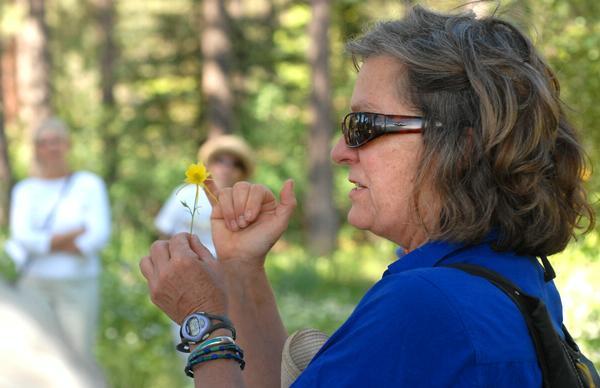 Special to the Sun
Special to the Sun
Monday, July 28, 2008
They ranged from novice earth-diggers to experienced gardeners and they studiously scribbled notes on steno pads and raised their hands to ask questions.
“It’s a matter of stewardship,” botanist Gwen Waring said to the 25 enthusiasts gathered for the annual Wildflower Walk at the Flagstaff Arboretum on Saturday. “As our ecosystems are disturbed and changed, we need to provide a refuge for our native plants that also welcomes animals into our garden. “I take an evolutionary approach,” Waring said. “There are 110 conifers, and they are ancient creatures. But flowering plants are so much more diverse. They developed strategies for pollination as they evolved. These exploded in the Cretaceous Period, evidenced by fossils from that time.”
Billed as a “Celebration of the Evolution of Flowering Plants,” Waring’s talk quickly focused on the birds and the bees. And moths and butterflies. And hummers — the tiny, zipping, territorial kind. Attention turned to these pollinators as Waring reached over to pluck a Golden Columbine. She noticed a bee, rolling in the anthers of a nearby flower to gather pollen and drew our eyes to the unsuspecting buzzer.
Delightedly, Waring giggled and said, “Ah, sex. It’s just the way of the world, and we just need to relax and let it happen.” She means we need pollinators to continue the life cycle.
Waring explained about endosperm, the part of the plant that is our nutrition in the world. An example is the corn kernel. Back to pines, Waring compared their lengthy three-year cycle of development to the seasonal speed of flowering plants’ maturity which transports nutrition to their roots through improved vascular systems with incredible efficiency .
“It’s just an amazing story,” she said and would say so many times thereafter, plugging her passion.
Since the last Ice Age, plants have produced strategies that get them noticed. A flower’s shape, size, color or fragrance draws us to them, but is intended for pollinators. Flowers — or corollas as they are called by those who know them well — which are red and tubular, for instance, are built for the long bill and color spectrum of a humming bird. A wide mouth, on the other hand, allows even the burley bumblebee access. Pink, the most generalized of the colors, draws hummers and others alike.
“Fragrance is a huge investment,” Waring said about blossoms. “And sometimes, plants use the ‘big bang strategy,’ as I call it.” For example, Scarlet Gilia’s stretching stalks bloom in their third season. “They have to get it right to get their genes into the next generation’s gene pool.”
Ah, but they have a back-up plan. If browsed by animals, the stalks create multiple stems made unpalatable via a change in chemistry.
“We call this overcompensation,” Waring said.
Noxious plants overrun native plants utilizing ingenuity as well, but they create mono-cultures. One tragedy, cheatgrass, is more abundant in Flagstaff than in the last 100 years. It blooms early and leaves tinder-dry swaths that carry fire. Knapweed, in its many forms, displaces native species.
“Life is full of endless experiments spewing out,” Waring said, referring to cultivation. “We’re serving the plants to extend their ranges and distribution. We are dispersers.” But, we have our responsibility in it.
A walk through the Arboretum’s 2,500-strong species of plants wouldn’t be complete without lingering in the Penstemon Garden.
“The highway department actually seeds the roadways,” Waring said of the Rocky Mountain variety.
There are up to 300 types found only in North America from Alaska to Guatemala, with 90 percent of them springing from Western soil.
“There is diversity in the West. It’s heterogeneous because the area is raw, crunched-up, creating opportunities for isolation to mix and match gene pools,” she said.
The standard, large corollas of fused petals contain many seeds and are generally purple with opposing couplets of leaves on their stems. Characteristically, penstemon’s concentrated nectar regenerates in two hours to encourage pollinators to return.
Variety abounds from the salmon petals of the Sunset Crater variety — endemic to the black-cindered, rotten soil — to matt penstemons who retain their groundcover greenness even in winter.
“Their story is absolutely amazing,” confirmed Waring.
Dig deeper at thearb.org for thorough plant lists plus native sources — local and farther afield. Options range from sun lovers for decorating mailbox posts to drought-hardy natives that spring from our rock-strewn soil.
Gwen Waring’s short list of plants to try:
Goldenrod–tough, spreading arches of sunny, clustered blooms
Wild geranium–profuse, fuchsia blooms in summer
Pussytoes–gray-green, paw-sized groundcover spreads among flagstones
Fleabane–lavender and yellow daisy; aster family
Coneflower–tall, showy flowers, often purple or yellow
Blanket flower–cultivated on reservations; drought-hardy red with yellow-fringed petals
Grama grass–low-traffic turf alternative
Wax currant–fruit-bearing shrub prefers sun
Showy goldeneye–abundant yellow sunflowers summer through fall
Globemallow–red and yellow perennial loves sun and attracts pollinators

